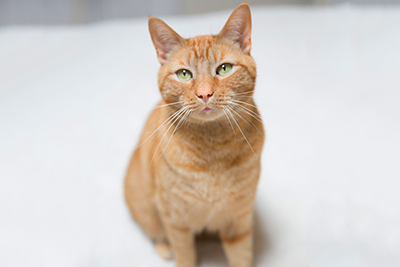
The term "seizure" is often used interchangeably with "convulsion" or “fit,” but what do all of these terms really mean is happening? A seizure starts as a result of abnormal, excessive electrical activity in the brain. According to Chelsea Sonius, of the Zimmer Feline Foundation, whether in humans or animals, all seizures:
- Start as a result of these electrical misfires in a part of the brain called the cerebrum.
- The abnormal electrical impulse spreads from cell to cell.
- This unregulated activity in one region of the cerebrum causes increased activity in other regions, a phenomenon termed "hypersynchronous activity."
- The brain becomes uncontrollably "hyper excitable," which leads to seizures. Convulsions can then cause a cat’s body to shake rapidly and uncontrollably.
How can one cat seizure differ from another?
Epilepsy.com says, “Seizures may take many forms.” The outward effect can vary from uncontrolled, violent, jerking movements (tonic-clonic seizure) to a subtle loss of momentary awareness (absence seizure), which may go unnoticed by others. The syndrome of recurrent, unprovoked seizures is termed epilepsy. Seizures can be brought on by either primary brain disorders, or they may develop as a result of a process outside the brain. Conditions like low blood sugar, liver failure (when it leads to “hepatic encephalopathy”) or conditions that make blood thicker (as happens with high red blood cell or protein levels), are examples of processes outside the brain that may cause seizures. In addition, certain cardiac events look a lot like seizures, but don’t predictably alter the brain’s electrical activity in the same way. Temporary loss of consciousness (syncope) or collapse, associated with some heart rhythm disturbances, can be very hard to distinguish from seizures in some cases.
How common is a cat seizure?
Seizures occur in both dogs and cats, but occur less commonly in cats. Zimmer.com estimates that approximately 2% of all cats are affected by some seizure disorder.
What are the underlying causes of a cat seizure?
Seizures occur at all ages and in all breeds; however, older cats are more likely to be affected by a variety of underlying causes:
- Tumors
- Trauma
- Infections
There is little evidence that seizures in cats have a hereditary component. Most cats with seizures will have some structural change in the brain contributing to the seizure disorder. Unfortunately, recent studies show that from 22% to 41% of cats had epilepsy of unknown cause; the neurologic work found no structural or blood-borne cause1,2,3.
What are the signs of a cat seizure?
Seizure activity in cats is often very violent, but can be quite variable. Common signs of seizures in cats can include:
- Sudden bursts of activity
- Aggression
- Drooling (hypersalivation)
- Facial twitching
- Loss of consciousness and uncontrolled muscle activity (tremors, twitching, and convulsions)
If you are unsure if your cat’s behavior is a manifestation of seizure activity, a video recording of an episode may help your veterinarian make that determination.
Click here to learn about the benefits of videotaping for your vet.
How is a cat seizure disorder diagnosed?
The first step in diagnosing a seizure disorder will involve a thorough history from you, and a complete physical examination for your cat. Blood tests will help eliminate some (metabolic) diseases, but additional testing will likely be required to find the cause. A number of seizure disorders in cats are associated with frequently operable brain tumors.
Testing could include:
- Spinal fluid analysis
- Advanced imaging , such as MRI or CT
- Electrodiagnostics (EEG) – limited to neurology specialists
How will a cat seizure be treated?
It is not uncommon for people and animals to have an isolated seizure at some time in their lives. There may or may not be subsequent seizures. A single seizure does not generally warrant treatment. Even with acceptable medical control, some individuals will have periodic seizure reoccurrences. Seizures themselves are generally not dangerous, unless they last a long time or are very severe, so an individual seizure may not warrant use of medication. Veterinarians try to balance the risk of treatment with an anticonvulsant against the consequences of not treating the seizure. If the seizures come frequently or are particularly distressing to you, or disruptive to the cat, discuss it with your veterinarian.
If testing reveals a primary or underlying disorder, options for treating that condition need to be considered. When necessary, medical treatment for seizure control involves trying to suppress the electrical impulse that would lead to a seizure. When giving anti-seizure medications to your cat, it is extremely important to work with your veterinarian to determine the correct dosage for your cat and to monitor for adverse side effects.
If your cat is having any event like a convulsion or fit that lasts more than 2-3 minutes, or is having repeated events, back to back in a 24 hour period, without a return to normal, (cluster seizures), you should seek emergency medical attention because these can be life threatening.
What is the prognosis of a cat seizure disorder?
The prognosis of seizure disorders is dependent on three factors:
- The frequency of seizures
- Your cat’s response to treatment
- The presence of an underlying cause
At best, the prognosis with treatment is uncertain because even in seemingly well controlled individuals, it is not uncommon to have a breakout seizure. It’s possible the prognosis will be unfavorable. Organic diseases like brain tumors and metabolic diseases may be progressive and seizures may be increasingly common or severe.
If you have any questions or concerns, you should always visit or call your veterinarian -- they are your best resource to ensure the health and well-being of your pets.
Resources:
- Joane Parent DMV, MVetSc, DACVIM (Neurology). Feline Epilepsy: Recognition, Evaluation and Treatment. ACVIM 2014. St-Hyacinthe, QC, Canada.
- Wahle AM, et al. J Vet Intern Med. 2014;28:182.
- Barnes HL, et al. J Am Vet Med Assoc. 2004;225:1723–1726.
